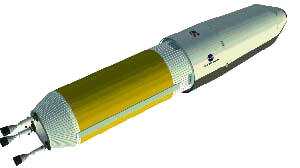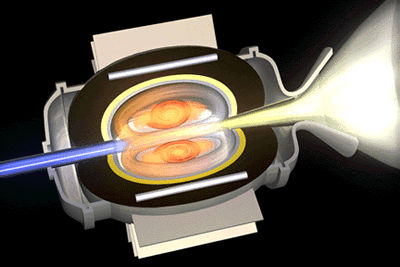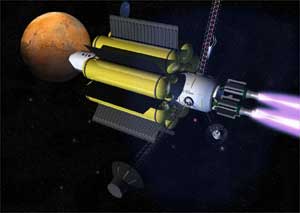The
Aeris Missions

The
First Aeris Mission
AERIS MISSION ON WAY HOME
After
being stranded on Aeris for several months longer than planned,
the crew of the Aeris mission is finnally on it's way back to Scandia.
In a daring space walk, Dr. Khazar Ihto and Dr. Shouzu Li were able
to replace the damaged reactor from the Aeris-1 and replace it with
a unit brought by a resupply ship. With the repairs complete, the
crew is now on it's way home, with even more complete data on Aeris
than anticipated. Source with the Mazrim Space Center have been
reported as saying that several in the Space Community are pleased
by the disasater, saying it was a chance for Andrea to demonstrate
it's space exploration prowess, as well as collect extra data.
Although the
Aeris-1 was designed to be resuable, it will likely be
dissassembled for study. It is also likely that the reactor and
drive systems will be redesigned. The lifesupport systems, based
on Montedorian and CRV designs reportedly exceeded expectations,
even given the extra strain of an extended stay on the surface.
Breaking
News: More on Aeris-1 Malfunction
October 16, 1512(Mazrim Space Center, Colma Island) -
With the latest
report from Mission Control here at the Mazrim Space Center,things
look grim for the Aeris-1 mission. Detailed inspections have revealed
that a micrometiorite passed through the reactor room of the ship,
penetrated the reactor sheilding, and sprayed molten debris inside
the main reactor. Luckily, emergency shutdown procedures kicked
in, but not before radiation from the reactor damaged computers
and electronics in the aft section of the ship.
The crew and conrol sections, which are extra sheilded, were not
effected. The main reactor has been completely disconnected, and
software is being reinstalled on computers. However, the reactor
cannot be reactived, due to the damage it has sustained.
Experts are working
on ways to repair the damage and rescue the crew. The crew still
have several months of supplies on the surface, and it is likely
that a second automated supply ship will be sent to aid them.
Breaking
News: Aeris-1 Malfunction
October 15, 1512 (Mazrim Space Center, Colma Island) - The SDC has
announce that the main drive system on the Aeris-1 orbiter, in orbit
around Aeris, has failed to respond to routine systems checks. "As
of 4:23 A.M. we have ceased to recieve any data from the primary
core or engines 2, 3, 4. Engine 1 has sent back data irratically."
announce Mission Controller Hansen Wu. Software glitches or micrometeorite
damage are the most likely causes of the malfunction. Exterior cameras
are being moved to the effected areas to see if there is any external
damage, while plans are being made to shtu down and restart the
effected systems.
NATION
REJOICES
The past few days have been one of national celebration as Andreans
became the first nation to reach Aeris, the fifth planet. Parades
were held in many cities, and school children spent most of the
day working on projects related to space travel and Aeris. The most
lavish celebration was thrown by the Ascendant,topping the extravegant
parties he has thrown in the past.
COVERAGE
BREAKS RECORDS
Over 97% of all Andreans are estimated to have watched the landing
live, and the continuous brocasting of the mission on several channels
are continuing to break viewership records. Advertising spots during
the landing when for as much as am3 million for a thirty second
commercial. A made-for-TV movie about the build up to the launch
reportedly made the NTN Network over Am70 million.
ASTRONAUTS
DOING FINE
The six person exploration team on Aeris have settled into thier
new home comfortably and begun research. Dr. Hiro Ikari said, "We're
glad to be in real gravity again, even if it's only 2/5 of what
we're used to. Eating all your food out of a tube loses it's novelty
after the first day."
Special
Report from Andrea
Mazrim Space Center,
Colma Island
At 06:47 (Andrea Time Zone),
September 5th 1512, the Aeris-1 space
craft arrived in Aeris orbit. The ground control and ship crew were
both ecstatic as the orbit was achieved without problems. Several
system checks were completed in the ensuing hours, and contact was
established with the base camp set up by the previous unmanned supply
ship.
At 14:12 the landing module,
the "Sparrow" detached from the transit
vehicle and began its descent. 17 minutes later, the call was
recieved, "The Sparrow has landed." Cheers filled the
control room,
and champagene was brought out. The most dangerous part of the
mission had passed without a hitch.
After donning their EVA
Suits, the crew made preparations to exit the
Sparrow and enter their new home, Velkor Base. The mission commander,
Major Mordekai Lysander became the first human to set foot on another
planet. His words on this historic occasion will be remembered for
ever. "With this step, the dream of generations is fulfilled."
The six person crew is:
Major Mordekai Lysander, Commander
Age: 36
Profession: Astronaut, former Air Force Pilot. Has commanded numerous
manned missions orbiting Scandia for the SDC and SSS.
Dr. Hiro Ikari
Age: 43
Profession: Astrogeologist, will be responsible for geologic research
on Aeris.
Dr. Shouzu Li
Age: 27
Profession: Computer Systems and Robotics. Designed many of the
components of the unmanned aspect of the mission, will maintain
the
automated systems.
Dr. Jessica Monroe
Age: 36
Profession: Astrobiologist. Will be responsible for the search for
native life on Aeirs
Dr. Wildflower Running
Wolf
Age: 38
Profession: Genetic Enginerer, Molecular Biologist. Will be
responsible for Scandia forming experiments.
Dr. Khazar Ihto
Age: 47
Profession: Materials Scientist / Engineer. Will conduct experiments
on in site construction and materials manufacture to investigate
using native materials for future bases.
Background
 The
Flagship mission of the Space development Consortium is the first
manned mission to another planet, Aeris. The fifth planet has always
held a special place in the hearts of Andreans, featuring prominently
in our legends and mythologies. It was due to the petitions of Ascendant
Madog, in fact, that Aeris has been internationally recognized as
the name of the fifth planet. The
Flagship mission of the Space development Consortium is the first
manned mission to another planet, Aeris. The fifth planet has always
held a special place in the hearts of Andreans, featuring prominently
in our legends and mythologies. It was due to the petitions of Ascendant
Madog, in fact, that Aeris has been internationally recognized as
the name of the fifth planet.
Ascendant
Mazrim has been even more interested in Aeris than his father. Not
satisfied with the robotic missions sent to Aeris in the 1480 and
90s, the Ascendant made a manned mission to Aeris one of the primary
goals of the SDC when he established it. To that end, the SDC has
engaged in international space efforts to acquire the needed expertise
in manned spacefight, environmental systems, and planetary landings.
 The
mission will be composed of two parts. The first part, the supply
mission, will be sent first to set up the base for the Astronauts
who will arrive six months later. The supply ship, the SS. Aeris
2, was launched on two NR-5 nuclear rockets from the Windmark launch
facility, and assembled in orbit by astronauts stationed at Mazrim
Station. The
mission will be composed of two parts. The first part, the supply
mission, will be sent first to set up the base for the Astronauts
who will arrive six months later. The supply ship, the SS. Aeris
2, was launched on two NR-5 nuclear rockets from the Windmark launch
facility, and assembled in orbit by astronauts stationed at Mazrim
Station.
It
uses three small solid-core nuclear rockets to propel it to Aeris.
Once in orbit, it will deploy it's cargo via parachute, to a predetermined
location. The supplies will automatically set themselves up to await
the arrival of the astronauts. The nuclear power plant of the ship
will form the core power plant of the base, allowing the astronauts
to have a ready supply of energy when they arrive. The components
left in orbit will serve to provide communication with Scandia,
and to survey the planet and study its weather.
 The
manned crew transport, the SS Aeris-1, will be powered by four new
high powered gas core nuclear rockets. These engines will provide
the highest sustained thrust yet achieved in a space craft, providing
a constant .05g for the crew. The constant thrust will allow a direct
voyage to Aeris in under two months, rather than the more traditional
approach involving gravitational assists and launch windows used
by the cargo ship. The GCNR will use hydrogen as it's main propellant,
superheated and expelled by the rocket. The hydrogen will be created
in flight from water that doubles as radiation shielding for the
crew. The production of oxygen will be a useful byproduct of the
reaction, as will a great deal of electricity. The
manned crew transport, the SS Aeris-1, will be powered by four new
high powered gas core nuclear rockets. These engines will provide
the highest sustained thrust yet achieved in a space craft, providing
a constant .05g for the crew. The constant thrust will allow a direct
voyage to Aeris in under two months, rather than the more traditional
approach involving gravitational assists and launch windows used
by the cargo ship. The GCNR will use hydrogen as it's main propellant,
superheated and expelled by the rocket. The hydrogen will be created
in flight from water that doubles as radiation shielding for the
crew. The production of oxygen will be a useful byproduct of the
reaction, as will a great deal of electricity.
The
ship itself will carry a crew of six, as well as all of the supplies
they will need for their five month round trip in space. The cargo
lander will contain all the supplies needed for their two months
on the planet. The ship will also be equipped with several small
rockets, probes, and satellites.
 Once
reaching the planet, the crew will descend in a lander, leaving
the Aeris-1 in orbit for the return trip. The crew will spend the
two months on Aeris surface conducting experiments searching for
signs of life, as well as further understanding the planet's weather
and and geology. They will also establish the basis for a more permanent
outpost on the planet. Most excitingly, they will perform experiments
on scandiaforming, or the process of turning a barren planet into
one more like Scandia. This may be a century long process, but it
the first step in one day establishing an Ascendancy of Aeris. Once
reaching the planet, the crew will descend in a lander, leaving
the Aeris-1 in orbit for the return trip. The crew will spend the
two months on Aeris surface conducting experiments searching for
signs of life, as well as further understanding the planet's weather
and and geology. They will also establish the basis for a more permanent
outpost on the planet. Most excitingly, they will perform experiments
on scandiaforming, or the process of turning a barren planet into
one more like Scandia. This may be a century long process, but it
the first step in one day establishing an Ascendancy of Aeris.
The
Aeris-1 will return to Scandia and orbit the planet near Mazrim
Station. The ship is designed to be reusable, but will undergo many
inspections and studies to further our knowledge of interplanetary
travel. It is hopped that the success of the Aeris-1 will spur the
construction of several more ships and many more missions!
|


 The
Flagship mission of the Space development Consortium is the first
manned mission to another planet, Aeris. The fifth planet has always
held a special place in the hearts of Andreans, featuring prominently
in our legends and mythologies. It was due to the petitions of Ascendant
Madog, in fact, that Aeris has been internationally recognized as
the name of the fifth planet.
The
Flagship mission of the Space development Consortium is the first
manned mission to another planet, Aeris. The fifth planet has always
held a special place in the hearts of Andreans, featuring prominently
in our legends and mythologies. It was due to the petitions of Ascendant
Madog, in fact, that Aeris has been internationally recognized as
the name of the fifth planet. The
mission will be composed of two parts. The first part, the supply
mission, will be sent first to set up the base for the Astronauts
who will arrive six months later. The supply ship, the SS. Aeris
2, was launched on two NR-5 nuclear rockets from the Windmark launch
facility, and assembled in orbit by astronauts stationed at Mazrim
Station.
The
mission will be composed of two parts. The first part, the supply
mission, will be sent first to set up the base for the Astronauts
who will arrive six months later. The supply ship, the SS. Aeris
2, was launched on two NR-5 nuclear rockets from the Windmark launch
facility, and assembled in orbit by astronauts stationed at Mazrim
Station. The
manned crew transport, the SS Aeris-1, will be powered by four new
high powered gas core nuclear rockets. These engines will provide
the highest sustained thrust yet achieved in a space craft, providing
a constant .05g for the crew. The constant thrust will allow a direct
voyage to Aeris in under two months, rather than the more traditional
approach involving gravitational assists and launch windows used
by the cargo ship. The GCNR will use hydrogen as it's main propellant,
superheated and expelled by the rocket. The hydrogen will be created
in flight from water that doubles as radiation shielding for the
crew. The production of oxygen will be a useful byproduct of the
reaction, as will a great deal of electricity.
The
manned crew transport, the SS Aeris-1, will be powered by four new
high powered gas core nuclear rockets. These engines will provide
the highest sustained thrust yet achieved in a space craft, providing
a constant .05g for the crew. The constant thrust will allow a direct
voyage to Aeris in under two months, rather than the more traditional
approach involving gravitational assists and launch windows used
by the cargo ship. The GCNR will use hydrogen as it's main propellant,
superheated and expelled by the rocket. The hydrogen will be created
in flight from water that doubles as radiation shielding for the
crew. The production of oxygen will be a useful byproduct of the
reaction, as will a great deal of electricity. Once
reaching the planet, the crew will descend in a lander, leaving
the Aeris-1 in orbit for the return trip. The crew will spend the
two months on Aeris surface conducting experiments searching for
signs of life, as well as further understanding the planet's weather
and and geology. They will also establish the basis for a more permanent
outpost on the planet. Most excitingly, they will perform experiments
on scandiaforming, or the process of turning a barren planet into
one more like Scandia. This may be a century long process, but it
the first step in one day establishing an Ascendancy of Aeris.
Once
reaching the planet, the crew will descend in a lander, leaving
the Aeris-1 in orbit for the return trip. The crew will spend the
two months on Aeris surface conducting experiments searching for
signs of life, as well as further understanding the planet's weather
and and geology. They will also establish the basis for a more permanent
outpost on the planet. Most excitingly, they will perform experiments
on scandiaforming, or the process of turning a barren planet into
one more like Scandia. This may be a century long process, but it
the first step in one day establishing an Ascendancy of Aeris.